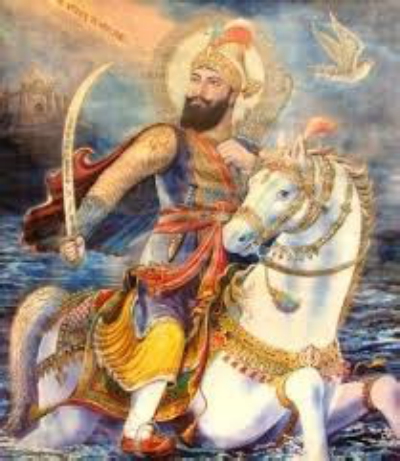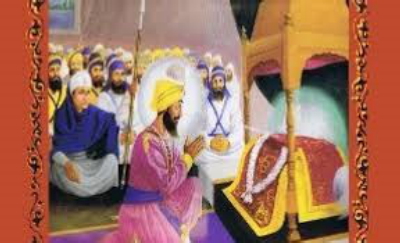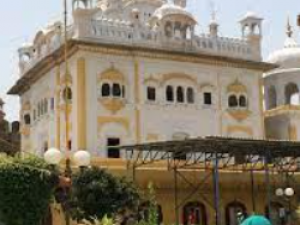 A few men in this world are born, who are endowed by nature with infinite capacity to face all trials and adversities of life with indomitable courage and strength. In peacetime they work for the betterment of mankind like a beacon of light. In times of calamity they rise up to protect the common men and women against atrocities and tyranny by the oppressive rulers. One such fascinating and dynamic personality was Guru Gobind Singh, the tenth Sikh Guru.
A few men in this world are born, who are endowed by nature with infinite capacity to face all trials and adversities of life with indomitable courage and strength. In peacetime they work for the betterment of mankind like a beacon of light. In times of calamity they rise up to protect the common men and women against atrocities and tyranny by the oppressive rulers. One such fascinating and dynamic personality was Guru Gobind Singh, the tenth Sikh Guru.
Guru Gobind Singh was born in Patna, Bihar (born 22 December 1666---died 7 October 1708). He was a spiritual master, warrior, poet, and a philosopher. He was the only son of Guru Tegh Bahadur, the ninth Sikh Guru, and Mata Gujri.
His father Guru Teg Bahadur was publically beheaded in Delhi on 11 November 1675 under the orders of Muslim emperor Aurangzeb for refusing to convert to Islam. The conflict between the Sikhs and the Islamic Empire thereafter continued. After his father's martyrdom, the young Gobind Rai later known as Gobind Singh was installed as the tenth Sikh Guru on 29 March 1676.
He was at that time of a tender age of nine years and a few months. The education of Guru Gobind Singh continued after he became the tenth Guru, both in reading and writing, as well as in martial arts such as horse riding and archery.
Guru Gobind Singh attained proficiency in many languages like Urdu, Hindi, Sanskrit, Persian, Braj Bhasha and Gurmukhi (script). He was endowed with an exceptional sharp intellect to understand the different scriptures of Hinduism like the 'Puranas' and the 'Bhagavad Gita.'
Guru Gobind Singh became an adept in the usage of weapons and horse riding at an early age. He had versatile interests and he learnt to play musical instruments also. Hymns and Shabads were sung to the accompaniment of tabla and harmonium by the assembly of Sangat in his presence.
Later after his marriage he had four sons. All his sons died during his lifetime in Mughal-Sikh wars. --- Two of his sons died in battle with the Mughal army, while his other two sons were executed by the Mughal Empire.
Among his notable contributions to Sikhism are founding of the Sikh warrior community known as 'Khalsa' in the year 1699, and introducing the Five Ks, which are the five articles of Sikh faith. These five articles are; Kesh: uncut hair; Kanga: a wooden comb; Kara: an iron or steel bracelet worn on the wrist;
Kirpan: dagger, and Kacchera: knee-length shorts.
These items were of utter necessity at that time as the Sikhs were under constant attacks from the Muslim Mughal army, which could take place at any time of day or night. The Sikh warriors were told by Guru Gobind Singh to be ready at all times and give a befitting reply to the enemy. Steel Kara and Kirpan were handy items in such hand to hand fights.
Guru Gobind Singh completed the formalisation of the Sikh religion and wrote important texts in his lifetime. He affirmed the scripture of Sri Guru Granth Sahib (SGGS) as the eternal living Guru of the Sikhs, as there was no further lineage of Guru's after him.
 Japji Sahib and Jaap Sahib The Guru Granth Sahib starts with Japji Sahib which was given by Guru Nanak; while the Dasam Granth starts with Jaap Sahib given by Guru Gobind Singh. The Jaap Sahib by Guru Gobind Singh is composed predominantly in Braj-Hindi and Sanskrit language, with a few Arabic words.
Japji Sahib and Jaap Sahib The Guru Granth Sahib starts with Japji Sahib which was given by Guru Nanak; while the Dasam Granth starts with Jaap Sahib given by Guru Gobind Singh. The Jaap Sahib by Guru Gobind Singh is composed predominantly in Braj-Hindi and Sanskrit language, with a few Arabic words.
The Japji Sahib by Guru Nanak gives hymns stating that one cannot clean the mind just by cleaning the body; by silence alone one cannot find peace; by food alone one cannot satisfy one's hunger. -- To be purified in body, mind and spirit, one must abide in the eternal love of One God (Akal Purakh- Ek Satnam-Wahe Guru).
Guru Gobind Singh in his Zafar-Naama addressed to the emperor Aurangzeb said, "When all other lawful means fail, then it is lawful to take to the sword."
...............
Stories of Guru Gobind Singh:
There is a story of a Muslim Pir who went to meet Guru Gobind Singh.
Muslim Pir said, "How can one meet God."
Guru Gobind Singh replied, "As night meets the day."
Muslim Pir said, "When night meets the day, then it is no more night." Guru Gobind Singh explained, "Indeed! --- The light of the day dispels the darkness of night. Your ego and 'Ahankar' is the darkness of night. When the human 'ego' meets the light and effulgence of 'God', then the darkness of ego disappears. --- It is kaam (lust), krodh (rage), lobh (greed), moh (attachment) and ahankar (conceit-ego) which are obstacles in meeting God. When all these defilements of darkness are removed, then only the pure Spirit of 'God' remains as the guiding light."
............
In the year 1684, Guru Gobind Singh wrote Chandi di Var in Punjabi language - a legendary war between the good and the evil, where the good stands up against injustice and tyranny, as described in the ancient Sanskrit text Markandeya Purana. He stayed in Paonta, near the banks of river Yamuna, till the year 1685.
Guru Gobind Singh in the Dasam Granth has written a section of Bani called Chaubis avatar. The Chaubis avatar is a collection of tales of the twenty-four incarnations of the Lord Vishnu, and it forms a part of the Bachitra Natak. The complete work contains a total of 4,371 verse units out of which 3,356 are accounted for by "Ram avatar" and "Krishna avatar." The longest is Krishna avatar with 2,492 verse units.
Guru Gobind Singh was a scholar of Sanskrit and he had mastery of the ancient Hindu scriptures of Puranas and Bhagavad Gita. --In Dasam Granth, Guru Gobind Singh describes the 'Krishna Avatar.'
But how does Sri Krishna himself describes the difference between an enlightened Yogi and the common worldly people in the scripture of Bhagavad Gita?
Holy book of Bhagavad Gita was given more than 5000 years ago in the form of a dialogue between Sri Krishna and his disciple Arjuna, on the battlefield of Kurukshetra during the Mahabharata war.
I give here excerpts from my book, "Word of God Bhagavad Gita."
Sri Krishna says to Arjuna in Bhagavad Gita:
That which is like darkness to all human beings (awareness of God Consciousness), to that the disciplined sage is ever awake; and to that in which all human beings are ever awake (material wealth, sensual pleasures and power), is like darkness to the soul-cognizing saint.
(Bhagavad Gita: Chapter 2 verse 69)
Commentary and explanation of the above verse by the author is as follows:
Transliteration from the Sanskrit to English is:
"Ya:---which:---Nisha:---darkness or night:--- sarva...bhutanam:--- to all beings:---tasyam:---to that:---jagriti:---is awake:---samyami:--- self-controlled:---yasyam:---in which:---jagriti:---awake:---Bhutani:---all beings:---sa:---to that:---Nisha:---like darkness or night:---pashyatah:---is cognized:---Muni:---realized saint."
When literally translated from Sanskrit to English, the verse reads as, "That which is night to all beings, in that the disciplined man is awake; and that to which all beings are awake, is night to the Atman-cognizing Muni."
Sri Krishna is talking here in the form of a metaphor, which contains a deep truth in a veiled form. Such verses with hidden meanings are meant to be known to only those who have a quest for knowledge, and not for mere curiosity.
Different commentators will impart different meanings to a metaphor, and will interpret according to their own intellect and understanding. This verse of just two lines contains great spiritual truth, and has to be pondered over again and again, to decipher its real meaning.
The above verse does not imply that while the whole world sleeps at night; the yogi keeps awake at night and meditates. Everybody whether a realized saint or a worldly person gets tired, and needs sleep to rejuvenate the body and mind.
The soul is a witness to all activities of life from birth to death, and at all times during day and night. The soul is a hidden aspect and worldly people are asleep and unaware of this aspect.
A realized saint has awareness of this and is always awake to the Self-soul and consciousness of God. The worldly people are always awake to name, fame, power, prestige, wealth, houses, cars and bodily pleasures of sex. The realized saint is asleep to all these material objects and sensual pleasures.
The yogi has awareness and a witnessing soul even in sleep. Awareness and dreaming cannot be together and for the yogi there is no dream state. Dreams are unfulfilled desires and a yogi is beyond any desires. Just a few hours of dreamless sleep is enough for the yogi to get refreshed.
Bible says, "No one can serve two masters. Either you will hate the one and love the other; or you will be devoted to one and despise the other. You cannot serve both God and worldly wealth." ............
Late Dr. Hari Ram Gupta an eminent Sikh Historian in his book 'History of the Sikhs (1469-1708)' has written the following story which took place in the lifetime of Guru Gobind Singh.
" ---- After the creation of the Khalsa Panth, a large number of Sikh gathering stayed back at Anandpur Sahib to get baptism from the youthful Guru Gobind Singh, who was then 32 years of age. A devotee Sikh presented a tiger's skin to Guru Gobind Singh. In the evening the Guru saw a donkey grazing in the field.
He instructed two of his followers to keep a watch on the donkey's movement. In the night, the tiger's skin was fastened on the donkey. Early next morning people in the locality raised an alarm as they were terrified at the sight of the tiger roaming around. Nobody dared to stir out of their houses. The Guru approached the donkey and removed the tiger skin.
The Guru then said, "You should be like a true fearless 'Khalsa' from the heart and not behave like a disguised donkey. Your persecutors and enemies are outwardly like lions, but inwardly they are cowards like this donkey. Face your enemies boldly, and they will be beaten and defeated. ----"
..............
Sikhism is a monotheistic religion based on the prayers to the almighty as the invisible, One Spirit of God as the Waheguru (Nirguna).
What does Sri Krishna say in 'Bhagavad Gita' on this important question? To answer this question, I quote here a few verses from my book "Word of God Bhagavad Gita."
Sri Krishna says to Arjuna in Bhagavad Gita:
The deluded are unaware of My Supreme Spirit of God as the great Lord of the entire Universe. The ignorant lack understanding and consider My Spirit of God, as dwelling only in My physical human Form (Saguna with attributes). ---
(Bhagavad Gita: Chapter 9 verse 11)
Another verse of Bhagavad Gita says:
But those who worship and meditate upon My Supreme Spirit as Imperishable, Indefinable, the Unmanifest, the Omnipresent, the Unthinkable, the Unchangeable, the Unmoving, the Eternal Spirit; and having controlled all their body senses, even-minded everywhere, rejoicing in the welfare of all beings; they also attain My Supreme Being.
(Bhagavad Gita: Chapter 12 verses 3 and 4)
Greater is their difficulty whose minds are set upon the absolute unmanifest (without visual form); for the goal of the unmanifest is very hard to attain for the embodied human beings.
(Bhagavad Gita: Chapter 12 verse 5)
The above verses clearly say that God can be realized both as in 'Manifest Form'; and also as 'Unmanifest' without any Form as One absolute Spirit. - - God is not a man or a woman sitting in heaven to pass judgments on the karma of 725 crores human beings on earth.
God is pure Spirit---Ek Onkar- -OM- Wahe Guru-SAT (True)-NAM (Name)-the true Name- -Omnipresent... Present everywhere-Omnipotent-Almighty--Unborn- -Eternal- -Imperishable-with eyes and ears everywhere-to hear and see everything- - All bliss- -Pure consciousness- - AKAL PURUKH- -Eternal Spirit---Self-existent--Self-effulgent- - from the beginning of the Universe---Consciousness which pervades the entire universe.
.........................
Footnotes:
Online book references on the internet: History of the Sikhs (1469-1708) by Dr. Hari Ram Gupta
Word of God Bhagavad Gita by Ajay Gupta
********
About the Author (Ajay Gupta):
Ajay Gupta has nurtured a deep passion for Bhagavad Gita and study of other spiritual books for the last forty years, which resulted in the writing of two research books on 'Bhagavad Gita.' His father late Dr. Hari Ram Gupta was an eminent Sikh historian and author of five volumes of Sikh History, and a dozen other research books.
The first book of Ajay Gupta, "Word of God Bhagavad Gita" was published in the year 2016 in India, and the second revised book, "God Speaks in Bhagavad Gita: for Young and Old: Complete book of wisdom with 700 Gita verses and enchanting stories" was published by Partridge, USA in the year 2017.
Both the books are available for purchase in India and globally in all countries as online Amazon paperback books and e-books. The author has the Indian and United States copyrights for the above published books.
Editor's Note: This article was originally published on Dec 20th 2017






